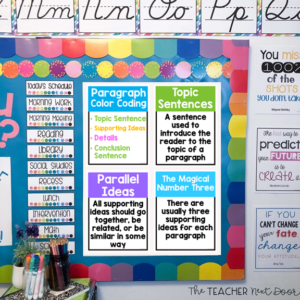
Teaching writing though is not always easy. What seems so intuitive to us, does not always seem natural to our students.
So, when I teach paragraph writing, I like to teach paragraph writing as if it were a recipe…First, you add this kind of sentence, then you do that… While at first glance, we may think true writing is not based on a recipe, but I think it provides an awesome start.
Think about a child learning to read… we start with letters and sounds, not novels, right? How about learning to play an instrument, we start with single notes and not symphonies.
In the same way, I like to teach writing by starting at a very basic level, with the idea that as students master the paragraph’s components, they are eventually able to use those as a springboard to beautifully written, creatively thought-out pieces.
When they have a solid foundation for writing, they can augment the recipe like a master chef might change a recipe in the kitchen.

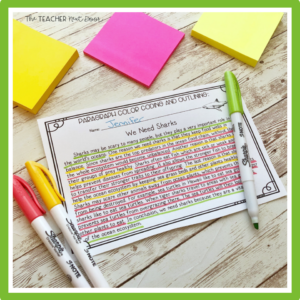
Once I introduce each part of the paragraph, I have students color-code a great deal, using paragraphs I’ve created or ones that previous students have crafted successfully. The example above shows a typical half-sheet paragraph, ready for color coding and outlining.
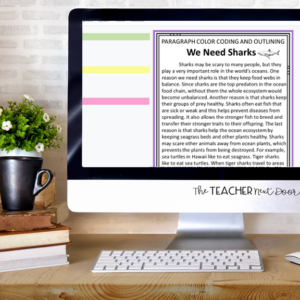
I like to place my copy on the document projector, while my students each have their own half-sheet. We go through the whole paragraph as a class, discussing each sentence and then color-coding it together.
The colors we use are: Topic Sentences and Conclusion Sentences are highlighted in green, Supporting Ideas are yellow and Details are pink.
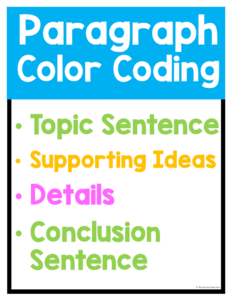
To highlight sentences, I let students use markers, colored pencils, or crayons so they can grab something quickly. Really, though, I prefer markers as they work the best to highlight papers. The one disadvantage to using markers is that they do tend to bleed through to the back of the paper where we do a reverse outline of the paragraph.
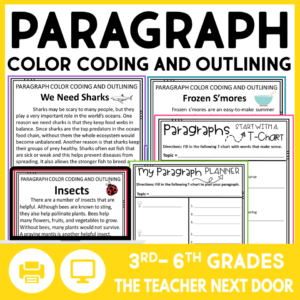
I really love the introductory color coding. It not only reinforces the concept of a paragraph and gives them a basic “recipe” for it, but these paragraphs serve as good writing models for students to follow.
Once we’ve finished color coding a paragraph, we flip our paper over and make a t-chart (words, not sentences) on the back in pencil. This reverse outlining reinforces the idea that every paragraph should have a certain organization and this is how the author organized his/her paragraph.
Here’s one of the T-Chart templates we use so you get a better idea of how students can create their own. The lightbulbs are for each of the supporting ideas (reasons that add proof to the topic sentence), and the numbers on the right are the details that provide examples and explanations that support each supporting idea.
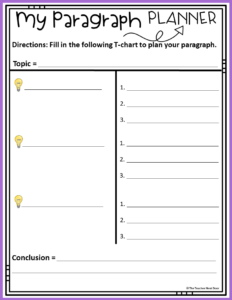
Of course, you can make your own paragraphs and materials for this but I do have a print and go resource to target these skills.
When I was in school, I know we never were taught that there were different types of topic sentences, that each could be identified and named, so this was a really new idea to me but one I have since fallen in love with. I purposefully teach students five different ways to create a topic sentence, and we spend a few days working on each type.
It’s my feeling that if students in grades 3 – 6 (and even higher) can master a basic set of five topic sentences and use them with ease, this puts them in good stead as growing writers. We go over examples together, students write a sentence on their whiteboards as I give them a topic, and we discuss how there are lots of “right” answers when it comes to writing, but also some choices that are better than others.
A List Statement tells the reader exactly what the paragraph will be about by listing the three supporting ideas. For example: My favorite sports include soccer, football, and basketball.
Number Words do not tell the readers each of the supporting ideas but use number words (many, few, a number of, four…) to present the general topic. For example: There are several things you can do to become a better writer.
Two Nouns and Two Commas topic sentences always start with a noun (a person, place, or thing), describe it, and then make a statement about it (an appositive). The description part of the sentence is surrounded by commas (one before the description, and one after it). For example: Roald Amundsen, an explorer, was the first to find the Northwest Passage.
Occasion Position topic sentences start with an occasion (a dependent clause) and use words like when, whenever, although, even though. They end with the writer’s position on the topic (an independent clause). For example: Whenever we celebrate the holidays, we always include some special traditions.
These topic sentences try to grab the reader’s attention by making a statement that is thought-provoking, controversial, or interesting. For example: The Italian Deli serves the best pastrami sandwiches downtown!
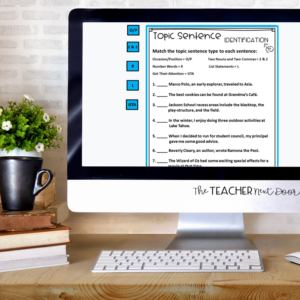
My Topic Sentence Resource explains each sentence type with lots more detail and has practice pages for each type as well.
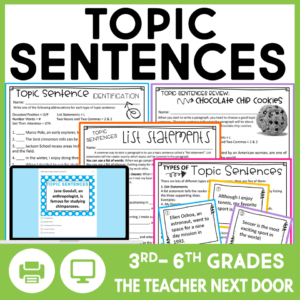
Once students have a pretty good handle on the five types of topic sentences, I love to do this really fun chocolate chip cookie review lesson. I start by telling the story of how chocolate chip cookies were invented by accident (a copy of the story is included in the Topic Sentence packet).
Then we do the handout that has lots of different kinds of topic sentences that all deal with chocolate chip cookies. When we finish correcting together, I used to love to pass out cookies for the kids to share…until the Health and Wellness policy changed at our school, and it became a no-no…grrr.
We also love to play a sorting game (in the Topic Sentence packet) that has students working in pairs to match up the topic sentences with their sentence type. Once “official” review activities are finished, I keep right on reviewing as we work on writing throughout the year.
For example, sometimes we might be writing a paragraph for an essay and one student will give me a topic sentence example, I might ask the class what kind of topic sentence it was. Or I’ll say, our topic is __. Who can make up an Occasion Position topic sentence for this topic?